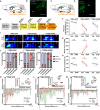A distinct parabrachial-to-lateral hypothalamus circuit for motivational suppression of feeding by nociception
- PMID: 33962958
- PMCID: PMC8104871
- DOI: 10.1126/sciadv.abe4323
A distinct parabrachial-to-lateral hypothalamus circuit for motivational suppression of feeding by nociception
Abstract
The motivation to eat is not only shaped by nutrition but also competed by external stimuli including pain. How the mouse hypothalamus, the feeding regulation center, integrates nociceptive inputs to modulate feeding is unclear. Within the key nociception relay center parabrachial nucleus (PBN), we demonstrated that neurons projecting to the lateral hypothalamus (LHPBN) are nociceptive yet distinct from danger-encoding central amygdala-projecting (CeAPBN) neurons. Activation of LHPBN strongly suppressed feeding by limiting eating frequency and also reduced motivation to work for food reward. Refined approach-avoidance paradigm revealed that suppression of LHPBN, but not CeAPBN, sustained motivation to obtain food. The effect of LHPBN neurons on feeding was reversed by suppressing downstream LHVGluT2 neurons. Thus, distinct from a circuit for fear and escape responses, LHPBN neurons channel nociceptive signals to LHVGluT2 neurons to suppress motivational drive for feeding. Our study provides a new perspective in understanding feeding regulation by external competing stimuli.
Copyright © 2021 The Authors, some rights reserved; exclusive licensee American Association for the Advancement of Science. No claim to original U.S. Government Works. Distributed under a Creative Commons Attribution License 4.0 (CC BY).
Figures






References
Publication types
LinkOut - more resources
Full Text Sources
Other Literature Sources
Molecular Biology Databases

